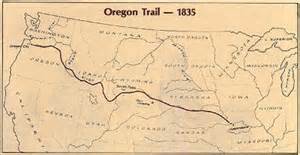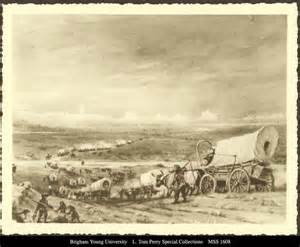The Oregon Trail was a 2,000-mile route to the West for thousands of settlers in 19th Century America. The Trail ran through what is now Missouri, Kansas, Nebraska, Wyoming, Idaho, and Oregon. The idea of reaching the West Coast began soon after Thomas Jefferson announced the Louisiana Purchase, in 1803, and commissioned Meriwether Lewis and William Clark to chart the course of the territory through to the Pacific Ocean. Lewis and Clark and the Corps of Discovery spent the better part of the next three years getting there and back again, and their reports emboldened many others to travel westward, sometimes for good. An 1810 expedition financed by famed furrier John Jacob Astor mapped out a slightly different route west.
The U.S. Government sponsored more than just Lewis & Clark. Explorers like Captain Benjamin Bonneville, John C. Frémont, and Kit Carson ranged far and wide and wrote about their experiences. The Oregon Trail wasn't an unbroken dirt road running direct from one place to the next; rather, it was a series of paths, trails, and wagon roads. Technically, the Trail wound from Independence, Mo., to Oregon City. As traffic on the Trail increased, other towns on the route became starting points; among these were the Kansas towns of Atchison and Leavenworth, the Missouri towns of St. Joseph and Weston; and the Nebraska town of Omaha. Other well-known settler trails were the Bozeman Trail, California Trail, Chisholm Trail, Mormon Trail, and Santa Fe Trail. The longest and most popular, however, was the Oregon Trail. The trails generally followed the Platte River and other waterways, passing through river valleys to enable access to fresh water and to grass for the animals doing the heavy lifting. Travelers were often in need of fire-burning materials. These often included trees, brush, abandoned wagons, and even animal droppings (the ever-popular "buffalo chips").
Travelers did not go west in straight lines. They spread out along the prairies and through the valleys, mainly to cut down on dust inhalation. They did resort to single file through narrow passes, however. Journeys to Oregon commonly took four or five months. Travelers took lots of food, stored in watertight containers or carried in packs. Some travelers traded what they carried for other types of food grown by people along the way. Some travelers took chickens, cows, and pigs with them, to use as food. Cooking was done over campfires. Not all meals were cooked. Travelers carried water, sometimes lots of it, but also depended on getting water along the way. (For this reason, a good part of the Oregon Trail was along waterways.) Travelers generally brought several sets of clothes, most importantly multiple sets of boots, and spare leather and threads and a few hand tools, to repair or replace clothing. Among the possessions kits were soap, washboards, and tubs, for cleaning the clothes. The common sleeping arrangement was on thin bedrolls, on the ground, inside tents (or under the night sky if the weather was good). Pregnant or infirm travelers or very young children sometimes slept on feather beds, inside wagons. Sleeping inside a wagon was not unheard of for otherwise healthy travelers as well. Conditions could be rough, and travelers commonly carried all manner of tools, including axes, shovels, hoes, hammers, saws, hatchets, picks, and crow bars. Sharing was essential for many travelers. Pooling of resources, including money, was quite common. Money was also essential to replace or obtain things broken or forgotten. With lots of time on their hands, travelers on the Oregon Trail found comfort in books, not just trail guides but as well the Bible and other popular publications. They also wrote letters, to drop at forts or posts along the way. For the most part, expendable items got left behind. Some travelers filled needs by picking up items discarded by previous travelers; others returned home with discards, selling them for a profit. Dangers were not unknown on the Oregon Trail. travelers encountered unfamiliar wildlife and sometimes hostile humans. Weather could be capricious, and supplies often ran low. Some mothers died in childbirth. Some young children didn't survive the ardors of the trip. Many travelers died, although exact figures are still not known, primarily because those who died along the way were usually buried in unmarked graves, to prevent looting. Disease was also common. Travelers' diets were sometimes low in fresh fruits and vegetables; and during the four-month trip, some travelers suffered from scurvy because of a lack of vitamin C. Other diseases, such as cholera, were familiar killers. One of the last stops on the journey west was Fort Vancouver, on the Columbia River. For a time, John McLoughlin was in charge at this fort. He helped so many settlers reach new homesteads that he became known as the "Father of Oregon." Other Hudson's Bay Company outposts were Fort Boise and Fort Nez Perce, both of which were quite happy to sell supplies to Oregon Trail pioneers. Travelers were still using the Oregon Trail while the Civil War was raging, but the advent of a railroad across Panama, allowing for ship-then-rail-then-ship-again travel, and then another, more famous railroad across the continental United States gave travelers much faster alternatives. The arrival of the automobile all but closed the Trail, with some state federal and state highways literally paving over parts of the Trail. The Oregon Trail didn't just disappear one day. Its use declined gradually. Signs of it can still be seen today, as can some wagon wheel tracks. It is now a National Historic Trail, with designating markers in several states. Many travelers didn't make it all the way to the West Coast, preferring to set up homestead along the way. This, in combination, with an influx of new settlers in Oregon and California, helped push the boundaries of the United States ever westward. |
|
Social Studies for Kids
copyright 2002–2024
David White

 After the War of 1812, the British presence on what is now the western part of the Oregon Trail increased, mainly through the efforts of the
After the War of 1812, the British presence on what is now the western part of the Oregon Trail increased, mainly through the efforts of the  Settlers traveled west along the Oregon Trail using combinations of walking or riding horses, and carrying supplies and necessities in covered wagons, known as prairie schooners, which were pulled by anywhere from 4 to 10 oxen or mules. (Horses were used to pull the wagons only in later years.) The well-known Conestoga wagons were, for the most part, too large and unwieldy for the arduous Oregon Trail, so settlers used prairie schooners instead. These wagons were typically 11 feet long, feet wide, and feet high and featured cotton covers treated with linseed oil, in an attempt to keep out dust, rain, and wind. Wheels were made of iron-rimmed wood and were 40-50 inches in diameter. The wagons were, for the most part, much too bumpy to ride in, despite popular artwork to the contrary.
Settlers traveled west along the Oregon Trail using combinations of walking or riding horses, and carrying supplies and necessities in covered wagons, known as prairie schooners, which were pulled by anywhere from 4 to 10 oxen or mules. (Horses were used to pull the wagons only in later years.) The well-known Conestoga wagons were, for the most part, too large and unwieldy for the arduous Oregon Trail, so settlers used prairie schooners instead. These wagons were typically 11 feet long, feet wide, and feet high and featured cotton covers treated with linseed oil, in an attempt to keep out dust, rain, and wind. Wheels were made of iron-rimmed wood and were 40-50 inches in diameter. The wagons were, for the most part, much too bumpy to ride in, despite popular artwork to the contrary. 
